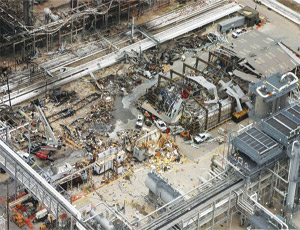Even as U.K.-based oil giant BP remains in the U.S. government’s crosshairs for environmental damage resulting from the Deepwater Horizon drill-rig explosion that killed 11 workers April 20, it now faces record fines and new scrutiny over another fatal accident five years ago at a land-based company facility in Texas.


BP agreed on Aug. 12 to pay a $50.6-million federal fine—the largest single penalty ever issued by the U.S. Occupational Safety and Health Administration—for not addressing safety violations found after a 2005 explosion at its Texas City refinery. The blast killed 15 contract workers employed by Jacobs Engineering Group Inc. and Fluor Corp., BP’s site contractors at the time. About 170 workers were injured.
The oil company also has agreed to spend at least $500 million to beef up safety protections at the plant, its largest in the U.S. and the nation’s third-largest refinery, but it denies safety violations there or failure to comply with a 2005 OSHA safety pact.
“The size of the penalty rightly reflects BP’s disregard for workplace safety,” said Secretary of Labor Hilda L. Solis. OSHA, which is part of the U.S. Labor Dept., had proposed penalties of more than $87 million. The penalty and OSHA citations “do not reflect the progress made at Texas City since 2005, which is why BP contested the citations,” says Robert Wine, a BP spokesman. “Rather than litigate the citations, OSHA and BP have agreed to put our differences aside and move forward collaboratively to continue a multiyear program to further enhance workplace safety at Texas City.” The firm paid $21 million in fines six months after the explosion in 2005.
Even so, BP will pay the new fine to resolve 270 of 709 citations OSHA issued last October; as well, the company agreed to penalties associated with its failure to correct problems found after the explosion by a 2009 agency inspection. Further, OSHA and BP have not negotiated a settlement on $33 million in penalties for 439 willful violations found during that inspection. “This is a strictly laid-out plan we didn’t have in the 2005 agreement,” says Jordan Barab, deputy assistant secretary of labor for OSHA. We have … spelled out how the oversight will proceed and what is acceptable and not acceptable.”
Jacobs and Fluor spokespersons declined to comment on either the fines, the agreed safety upgrades at the site or whether they are still working at the Texas City site.
The new agreement immediately requires BP to perform equipment safety reviews on a defined schedule and make permanent corrections; the company will complete pressure-relief and layer-protection analyses of all plant equipment and protect employees from any risk of catastrophic releases. Further, on a defined schedule and with OSHA monitoring, BP must install safety instrument systems to control serious hazards and correct pressure-relief deficiencies.
“Our area director will have monthly meetings with the [BP] plant director,” says Barab. “We will be receiving detailed quarterly reports from BP on the progress [of] problem areas and action plans to address those problems, and we will have independent, third-party verifiers.” BP also agreed to establish a liaison between OSHA and the company’s North American and London boards of directors to raise compliance issues.
“Every single employee in this country has the right to a safe workplace,” Barab says. “BP has the means—the financial means and the technical means—to make that refinery safe, and we intend to make it safe.”
In an e-mail to ENR, Tony Buzbee, a Houston attorney who has represented people adversely affected by BP operations, says, “We believe the fine to be appropriate and welcome the government’s efforts in our quest to force this British [company] to comply with U.S. and Texas law. BP’s horrid safety record rivals the worst in U.S. history.”
OSHA is not the only government entity scrutinizing the Texas City plant. On August 9, Texas Attorney General Greg Abbott charged BP with illegally emitting some 500,000 pounds of harmful air pollutants earlier this year. He seeks civil penalties of up to $25,000 per day per violation of state air-quality laws. The same operating compressor unit that malfunctioned and led to the 2005 fire was responsible for the 2010 emissions, officials say.
In June 2009, Abbott filed suit, alleging the plant’s poor operational practices led to the harmful release of contaminants for more than 160 hours after the March 2005 explosion.
Separately, a long-standing feud between the U.S. Environmental Protection Agency and the Texas Commission on Environmental Quality reached a boiling point concerning the regulation of industrial emissions and plant operating permits in the state. EPA’s regional office in Dallas now is threatening to take over state programs, although negotiations are continuing between federal and state officials, along with industry and environmental groups. The dispute dates back to the Clinton Administration, when EPA missed deadlines for making decisions about Texas permits, and the state commission interpreted that action as a green light to issue permits without federal approval.

Post a comment to this article
Report Abusive Comment